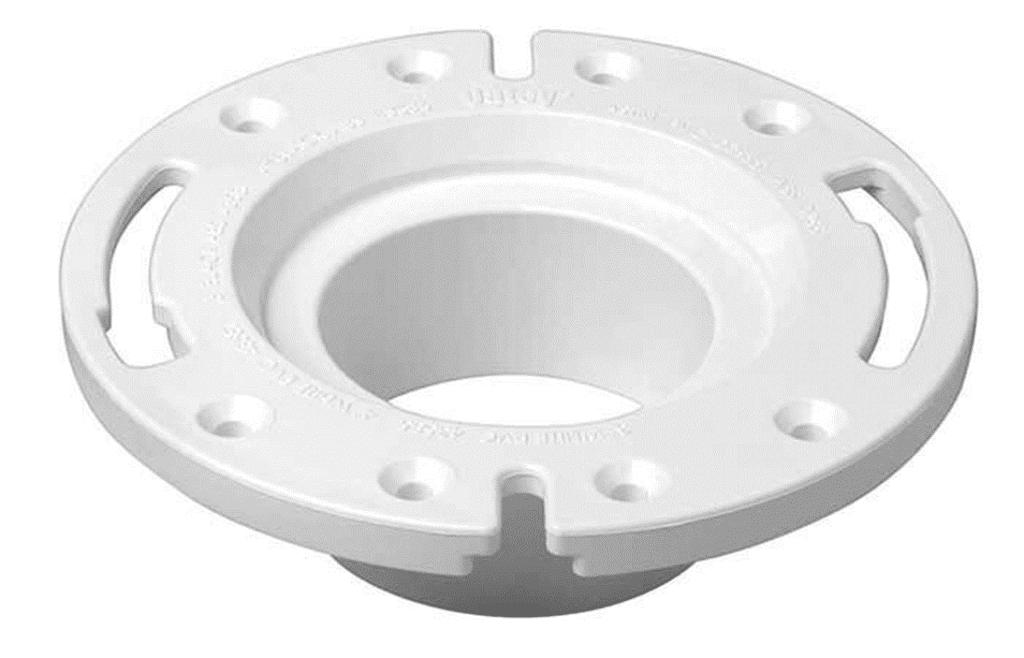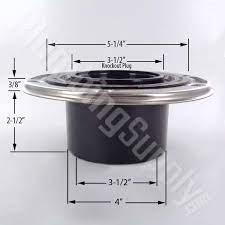Are all toilet flanges the same? Well, it is very important to use the appropriate flange for connecting your toilet to your house’s drain pipes. In addition, it is important that you use a flange that is sturdy so that it won’t break or cause damage to your plumbing. A toilet flange is responsible for holding your toilet in position.
There are usually about 3 or 4 inches wide and can be made from various materials, including metal, plastic, and wood. Typically, toilet flanges are designed to fit into a drain or be fitted over a drain.
Standard Size for Toilet Flange
There are different sizes of toilet flanges ranging from a standard four-inch or three-inch flange to an odd-sized flange. It is important to measure the widest area of the flange on your toilet to get the correct size flange for the bathroom. This is the top and bottom of your toilet.
Also, please note that the size of a toilet flange depends on your toilet type and the piping system that your toilet uses.
1. The 3-Inch Toilet Flanges
These flanges have 3-inch diameters on the bottom and top areas. Installation is a breeze, so long as you have the right size pipe.
If you don’t have a 3-inch pipe, please use a different flange to support it. This will improve the area’s look and allow you to easily place the pipe.
You can find four inches long flanges with four-inch diameters at the bottom and top area. However, these are very rare compared to the three-inch flanges you find in the closet.
2. Standard 4×3-Inch toilet Flanges
Standard 4×3-inches toilet Flanges are available in most stores and are available to order online. The 4×3-inch size is a popular size and fits most toilets.
4×3 indicates two different sizes of the flanges that fit around the toilet: the one at the top that connects to a toilet and measures four inches in diameter; and the one that fits over the drain.
From the measurements, the bottom opening is narrower than the top opening, which is convenient because it accommodates wide toilets.
3. Odd-Sized Toilet Flanges
There are flanges that are smaller or larger than the standard 4×3-inch toilet flange. Some toilet bowls have a very small bottom diameter and a large top diameter (about 6 inches). Such bowls are quite unusual, and you may need flange extensions to allow them to be installed higher to accommodate the new toilet bowl.
Some toilets have a diagonal opening to allow for additional space, particularly if the old toilet bowl is long enough to allow the new bowl to fit through the opening.
3 Inch vs. 4 Inch Toilet Flange. Which One Should You Use?
The length of a flange you need for a toilet depends on the size of the drain pipe you are using (or what size of flange you need for your toilet). Many flanges have 3 or 4 inches wide openings; some toilet models have larger flanges that will fit three or four inches of pipe.
It has an opening on the top that is larger than the one on the bottom, which is helpful when using larger toilets.
If your drain line is 4 inches wide, you’ll require a 4 × 4-inch flange. 4-inch drain pipes can hold more water, and they’re used when a lot of toilets are plumbed to the same line.
How to Measure Diameter of Your Toilet Drain
The diameter measurement is typically taken across the largest part of the toilet flange.
Two large flanges connect the drain to the main piping system in your home. You will find sizes that are 4×4, 3×3, or 4×3. These are the basic dimensions that describe the openings that your toilet possesses.
Toilets are designed to drain using a standard capacity, but if you have a special toilet, you should verify this.
So, now, let’s jump to;
The Different Kinds of Toilet Flanges
Even though most people use flanges that are pretty standard, there are 6 different materials from which toilet flanges are made. Each material has its pros and cons.
Brass Flanges

Brass is made from zinc and copper, making it very durable. It’s resistant to corrosion and rust.
It is very malleable, meaning you can make any shape you want. You can purchase flanges with a circular top or flanges that include elbows so that you can attach the pipe to the flange more easily.
One potential con of using brass is that it can oxidize when exposed to air, which would cause it to become darker over time. It is also very heavy.
Copper Flanges

Copper flanges are durable because they resist corrosion. Some models are flexible, which allows them to be molded to the piping, while others are rigid.
The softer the toilet flange, the easier the installation process. This is especially true when working with hard copper pipes; you will require elbow joints to attach the flange to the piping.
Copper is naturally antibacterial and antifungal, so it’s a good option for your plumbing.
PVC Plastic Flanges

PVC is the most common plastic used to make toilet flanges. It is super light and very durable.
But you shouldn’t be surprised. These flanges can be customized to fit virtually any drain system and are affordable.
As mentioned, PVC plastic is extremely lightweight, allowing it to be utilized in commercial and residential settings. PVC plastic is extremely affordable and is more durable than normal plastic.
There are toilet flanges made from tough ABS plastic, also used to create airplane wings. ABS is more costly than PVC plastic, but it’s better at handling huge waste.
Some plastic flange models are made from 100% plastic. But some have metal panels on the top to assist with the fit.
The biggest disadvantage of PVC plastic is that it’s very likely to be damaged when exposed to high pressure.
Cast Iron Flanges

What you need to know about flanges made of cast iron is that they are only designed to accommodate cast iron pipes. If you do not have a pipe that uses cast iron, this flange will be useless for you.
Unlike the other flanges, a cast iron flange is curved and fits more securely into your pipe. It can be welded to the pipe or welded to the end of a pipe. It is made to be longer than a pipe and can be positioned more securely to safeguard it.
This toilet flange works best if your plumbing is below the floor. One drawback is that it’s the quickest rusting of the six metals.
Stainless Steel Flanges

Stainless steel is commonly used for kitchen appliances. Nevertheless, it is also useful in bathrooms. Stainless steel is very durable and resistant to corrosion and rust.
It seals better than many other flange materials.
However, flanges that say stainless steel only have a thin layer of stainless steel around a wax ring. The rest of the flange is crafted from other materials. The rest of the flange is made from copper, iron, or plastic.
There are many different types of stainless steel. Some advanced stainless steels are made from silicone, which prevents rusting. Stainless steel is lighter than brass and easier to work with.
Aluminum Flanges

Aluminum is strong and resistant to rust. It is relatively light and easily welded onto other metals, including copper or iron. It is also relatively cheap compared to stainless steel.
Unlike stainless steel, most aluminum items are limited to the type of ring that covers the edges of the product. But some products are made entirely from aluminum.
The best kind of aluminum is unadulterated aluminum. It’s strong and can resist corrosion. If aluminum is mixed with other metals, like copper or zinc, it could become more durable.
FAQs
Can you install a new toilet flange over an existing one?
Apply a good amount of 100% silicone caulk coat to the old flange and the bottom of the new flange. Also, insert new flange bolts into the bottom of your new extender. You can put the new bolts in the old flange before you add the extender, or you can place them after you have attached the extender to your old toilet flange.
How do you know which toilet flange to use?
Choosing the right flange for the DWV pipe you are installing depends on the pipe material it is connected to. So, if you have a connection to a PVC pipe, you should use a PVC pipe flange to attach it to the toilet. You will need a cast iron flange for a connection that uses cast iron.
Wrap Up
Typical toilet flanges are 4×3 inches long, but you might find some odd sizes somewhere along the way. You want to ensure that the flange on the toilet bowl connects to your existing piping system. Most toilet flanges are rated for a maximum of 40 inches. Because most toilets are standard, so most models shouldn’t be a problem. Typical toilet flanges are 4×3 inches long, but you might find some odd sizes somewhere along the way.
You want to ensure that the flange on the toilet bowl connects to your existing piping system. Most toilet flanges are rated for a maximum of 40 inches. Since most toilets are standard, so most models shouldn’t be a problem.

Amos Christen graduated with a bachelor’s degree in Interior Design from Drexel University — Philadelphia, PA. Since 2003, Amos has worked with top interior design professionals in this area, including architects and interior/graphic/lighting designers. As a skilled interior designer, Amos Christen is highly versed in fine arts and crafts and uses that to supplement his main area of expertise. He often publishes articles related to home décor on several websites, including Sprucetoilets.com, Sprucebathroom.com, and Mybesuitedhome.com. He also contributes to leading interior design magazines.
